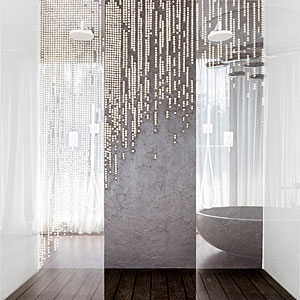Wall covering ideas, from knitted fabric to powdered insect wings

Simply sign up to the Life & Arts myFT Digest -- delivered directly to your inbox.
Electrical copper yarn, synthetic horsehair and polyester ribbon are not materials typically used to cover walls. Nevertheless, Belgian textile consultant Luc Druez has spent the past 18 years weaving and transforming such materials into wall panels and translucent drapes for clients including Chanel and Dior, as well as several top hotels around the world. Increasingly, such textiles are being used in homes as an alternative to paint or traditional wallpaper.
Druez’s textiles are an example of the growing number of unusual wall coverings now available – from embossed metal panels and stone tiles fashioned to look like draping fabric to colourful cowhide finishes.
A good selection of these items can be found in the London studio of Fameed Khalique, a high-end supplier who works with about 35 design companies to source the latest wall coverings, lighting and flooring. “Interior designers want things that are special and different, like real peacock feathers woven together in a fabric,” explains Khalique, who has also sought out rarities such as embroidered rabbit fur and panels made of crocodile skin.
His latest find is a collection of copper and recycled aluminium tiles by Canadian company DXU, which he launched at the London Design Festival in September. The embossed tiles feature different patterns such as a symmetrical brocade and florals inspired by the jungles of Borneo. The tiles’ effect is dramatic (one of DXU’s biggest clients is the entertainment company Cirque du Soleil), but Khalique says that the tiles would work well on a wall or alongside a staircase inside a home.
Another striking covering he stocks is a pearl-studded wall treatment designed by Romanian artist Mihaela Damian. The “pearls”, made from acrylic beads coated in resin, can either be used to embellish walls or to create individual pieces of wall art.
There are plenty of more subtle options, too. For example, New York-based designer, Be Inthavong, weaves fine strips of leather with silk to create shimmering fabrics. His collection has been used in yachts and private jets as well as for high-end handbags.
Inthavong’s textiles are woven by hand at his family silk mill in Vientiane, Laos, and are coloured using traditional techniques. One particular shade of grey is made by grinding up insect wings in a pestle and mortar and mixing them with rice water (the only method, Khalique says, that will result in this particular colour). The method may be old-fashioned, but the effect is strikingly contemporary. Interior designers are now using the textiles to cover entire walls (at about $375 a yard), as headboards, or in the panels of a wardrobe or screen.
Druez initially developed his textiles to see how fibres reacted to light. He says that, by changing the density of the weave, it is possible to alter the appearance of a fabric dramatically. Textiles can also create the illusion of extra space, says Druez, making a room look wider or longer.
Also useful for creating spatial illusions are the antique mirrored finishes of Gorman Studios, a favourite of English interior designer Katharine Pooley, who uses them “to add space and to create impact”. The studio specialises in decorative painting, including verre églomisé, an ancient technique of painting on to mirror.
Bespoke Global is an online business that sources products for the home using a selection of artists and designers. One of their artists, Fay McCaul, makes knitted fabric pieces incorporating LED fibre optics and iridescent acrylic as well as tiny mirrors. The fabrics are made by knitting rows of miniature pockets that hold the reflective materials. Her textiles have been transformed into art pieces, kaleidoscopic screens and entire wall coverings.
Another artist is Brooklyn-based Darcy Miro, who has developed three-dimensional wallpaper. She creates hundreds of delicate white bronze pieces – little spears or leaves – which are installed in a regular, repeated pattern on the wall.
More traditional is the work of Genevieve Bennett, a textile designer whose embossed and sculpted leather wall panels are inspired by Elizabethan armour and 17th-century wood carvings.
Bespoke Global has worked on several installations using Bennett’s panels in dining rooms and living rooms. Her floral and geometric motifs appear to pop out from the walls and – because the service is bespoke – Bennett can incorporate patterns from existing pieces of furniture into her work.
Pippa McArdle, co-founder of Bespoke Global, says demand for unusual wall treatments has grown in the past year. “We had people coming to us saying, ‘I don’t want paint, I don’t want wallpaper, I don’t want anything that can be purchased in a store or from a design studio, I want something that cannot be replicated.’” She believes the increasing popularity of wall coverings reflects the current appreciation for handmade or artisan products inside the home. “There is a decorative movement happening,” she says. “We see a lot more pattern, a lot more bravery in what people are willing to do in their homes. A lot of our clients entertain in their homes and for them it’s a way to encourage self-expression and not be beige on beige.”
Pooley agrees. “I think everybody is done with paint,” she says. “I’m going through a stage of wanting something different. People want things that will lighten up space, features that people will come in and talk about – a little bit of glamour.”
Comments